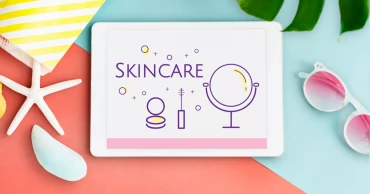Hair
How to Protect Your Skin and Hair from Sun Damage
To maintain the health of skin and hair, it is essential to take regular care in every season. The heat waves during summer months cause sweating and dehydration. Understanding how to protect and nourish the skin and hair can help you to minimise damages caused by sun heat. This article will explore effective tips to keep your skin and hair healthy, glowing, and protected during the warmer months.
Skincare Tips for Summer
.
Hydration is Key
Drinking plenty of water throughout the day is important to stay hydrated from within. Proper hydration helps maintain skin elasticity and suppleness, preventing it from becoming dry and flaky under the summer sun. It also keeps you safe from heat stroke caused by the scorching summer heat.
Cleansing and Exfoliating
You should cleanse your skin twice daily to remove sweat, dirt, and sunscreen buildup. It is also necessary to exfoliate regularly to unclog pores and remove dead skin cells. It can promote a smoother and more radiant complexion.
Read more: Collagen Supplements: Benefits, Side Effects, Dosage
Lightweight and Non-Comedogenic Products
It is highly recommended to opt for lightweight, oil-free moisturisers, serums, and sunscreens that won't clog pores or feel heavy on your skin. Try to look for products labelled "non-comedogenic" to prevent breakouts.
Introduce Antioxidants
It would be beneficial to incorporate antioxidant-rich skincare products into your routine to combat free radical damage caused by UV radiation and environmental pollutants. You should look for ingredients like vitamin C, vitamin E, and green tea extract.
Sun Protection
It is crucial to apply sunscreen with a high SPF (Sun Protection Factor) to all exposed areas of your skin, including your face, neck, arms, and legs. Reapplying sunscreen every two hours is equally important, especially if you are swimming or sweating.
Read more: How to Choose the Right Sunscreen for Your Skin
Customised Skincare
Not every person has same type skin. Customising skincare routine acording to the specific type and condition of skin can help to avoid rashes and other skin related issues.
It is vital to tailor your skincare routine to suit your skin type. If you have oily skin use oil-free water-based products, hydrating products for dry skin, and use gentle, non-irritating products for sensitive skin.
Use Sun Protection Clothes and Acessories
Experts suggest to wear lightweight and breathable clothing during extreme hot weather. It would be wise to choose light-cloured and cotton fabric made clothes to stay safe from heat exhaustion.
Besides choosing summer-freindly outfits, you need to use protective acessories like umbrellas, hats, and sunglasses for added protection.
Read more: Korean Skincare Routine: 10 Skincare Hacks
Healthy Eating
It is very important to eat a balanced diet rich in fruits, vegetables, and omega-3 fatty acids to nourish your skin from the inside out. You should limit your sugary and processed foods intake, which can contribute to inflammation and breakouts.
1 year ago
Winter Hair Fall Issues: Causes, and Solutions
As winter draws near, many individuals suffer the seasonal woe of increased hair loss. During the cold weather days, proper hair care is essential to maintain healthy and luscious hair. Let’s explore the reasons and remedies of winter hair loss.
Common Hair Fall Issues in Winter Season
Excessive Hair Shedding
During winter, many people notice an increase in hair shedding. It is normal to lose some hair daily, but excessive shedding can be a concern.
Dry and Itchy Scalp
The dry winter air can lead to scalp dryness and itching. This discomfort can also exacerbate hair fall issues.
Read more: Hair Fall after Pregnancy: Causes and Solutions
Brittle Hair
The lack of moisture in the air can make hair more brittle and prone to breakage, leading to further hair fall.
The lack of moisture in the winter air can render hair more fragile and susceptible to breakage. And, it ultimately results in increased hair fall and diminished hair health.
Causes of Losing Excessive Hair during the Cold Months
Cold, and Dry Air
The cold winter air, devoid of moisture, actively parches hair, leaving it dry and highly susceptible to damage. Without adequate humidity, hair's natural moisture balance is disrupted. This makes hair prone to breakage and other winter-induced issues like hair fall.
Read more: Monsoon Hair Fall Prevention: How to Care for Hair during Rainy Season
Steamy Showers
Steamy showers, although comforting in winter, can contribute to hair fall. The excessive heat and steam strip the hair of essential oils and leave it dry and fragile. This, combined with the dry air can exacerbate the problem and make hair more prone to shedding.
Heat Styling
Heat styling is a common culprit behind winter hair fall. Excessive curling irons use, straighteners, and hair dryers rob the hair of moisture. Such practices make the hair brittle, more likely to break and leads to increased hair shedding.
Nutritional Deficiencies
During winter, nutritional deficiencies can pose a significant threat to hair health. Colder weather often leads to dietary shifts and potentially deprives your body of vital vitamins and minerals crucial for maintaining healthy hair. Such deficiencies weaken hair, making it more susceptible to falling out.
Read more: Which is the Best Country for Hair Transplant?
Stress and Lifestyle Factors
Stress and alterations in winter routines play an active role in hair fall problems. Seasonal changes, coupled with holiday stress, disrupt the body's equilibrium and affect hair growth cycles. This is how increased stress levels can exacerbate hair loss.
2 years ago
Hair Fall after Pregnancy: Causes and Solutions
After the remarkable journey of pregnancy and childbirth, many new mothers encounter postpartum health issues. One common concern is hair fall, which can be distressing for these mothers. Understanding the reasons behind postpartum hair fall and discovering effective solutions is crucial to helping women regain their confidence and maintain their hair health.
Reasons behind Hair Loss after Pregnancy
Hormonal Changes
During pregnancy, a woman's body experiences significant hormonal changes to support the growth of the baby. After childbirth, hormone levels, particularly oestrogen, drop abruptly. This hormonal shift can trigger hair shedding, often noticed a few months after giving birth.
Stress and Fatigue
The demands of caring for a newborn often result in overwhelming fatigue and stress. It affects a mother's mental and physical health. Elevated stress levels and constant exhaustion play a role in hair fall, disrupting the natural hair growth cycle and adding to the concerns of postpartum women.
Read more: 10 Ways to Ensure Emotional Well-being during Pregnancy
Thyroid Problems
Thyroid issues post-pregnancy can exacerbate hair fall. Fluctuating thyroid hormones, common after childbirth, can disrupt the hair growth cycle. An underactive or overactive thyroid adversely affects hair quality and contributes to increased hair shedding. It compounds the challenges of postpartum hair loss for new mothers.
Iron Deficiency
Iron deficiency, prevalent after pregnancy, can be a significant factor in postpartum hair fall. Inadequate iron levels impede the transportation of oxygen to hair follicles. This affects hair health and leads to increased hair loss. It is a concern frequently experienced by new mothers.
Medications
Certain postpartum medications may trigger an unintended hair fall. Some medications, such as blood thinners and antidepressants, can cause hair loss as a side effect. New mothers need to consult healthcare professionals about potential side effects on hair and explore alternative treatments if needed.
Read more: Best foods for expecting mothers
2 years ago
Monsoon Hair Fall Prevention: How to Care for Hair during Rainy Season
This year, the sweltering summer heat is lingering, and the monsoon's arrival remains elusive. With soaring heat, the anticipation for the much-awaited monsoon grows. However, with refreshing rain and lush greenery, monsoon comes with some challenges, particularly for our hair. The rainy season can lead to several hair problems, with hair fall being a common concern. So, let’s explore why it occurs and essential tips to care for hair during this damp and humid season.
Why do we lose hair during monsoon?
According to a research study published by the World Trichology Society, people tend to experience approximately 30% more hair loss during the monsoon season than other times of the year. During this time, the atmosphere becomes more humid, causing the hair to absorb excess moisture. This makes the hair shaft swell, weakening its structure. Additionally, the scalp becomes more susceptible to fungal infections due to the accumulation of sweat and dirt.
These factors collectively contribute to increased hair fall during the rainy season. Furthermore, the change in weather conditions affects our hair growth cycle. The hair follicles may enter a resting phase, leading to excessive shedding. Moreover, the lack of proper care during this period exacerbates the issue, resulting in dull, lifeless, and fragile hair.
Read more: Which is the Best Country for Hair Transplant?
How to care for hair during rainy season
Keeping hair dry
As much as possible, one should try to keep hair dry during the rainy season. Try to use an umbrella or a raincoat with a hood to protect your hair from getting drenched. If your hair gets wet, make sure to dry it gently and completely as soon as you can.
Cleaning hair regularly
Frequent shampooing is essential during the monsoon to cleanse the scalp and hair from sweat, dirt, and excess oil. It would be better to opt for a mild, pH-balanced shampoo that suits an individual's hair type. Avoiding hot water is highly suggested, as it can strip hair of its natural oils, leading to dryness and frizz.
Conditioning hair properly
Conditioning is a vital step in monsoon hair care. Experts suggest applying a good-quality conditioner from mid-length to the ends of the hair after shampooing. This helps to restore moisture and smooth down the cuticles, reducing frizz and breakage.
Read more: What's Hair Transplant and What are the Most Popular Methods?
Combing wisely
For a proper monsoon hair care routine, it would be great to use a wide-toothed comb to detangle gently. It ensures enough space between the teeth to prevent hair breakage.
One should avoid combing wet hair immediately to minimise breakage.
Also, refraining from sharing combs, especially during the monsoon, reduces the risk of fungal infections and helps to maintain healthier hair.
Avoiding hairstyling when wet
Trying hairstyles with wet hair is highly discouraged, as it weakens the hair follicles and leads to increased breakage. Wet hair is more susceptible to damage, and the tension from combing can cause stress on the already fragile strands. It would be the best option to allow hair to dry naturally before styling it to maintain strong and healthy hair.
2 years ago
Which is the Best Country for Hair Transplant?
When it comes to hair transplants, finding the right country to have the procedure done can be a daunting task. There are many factors to consider, including the expertise of the surgeon, the cost of the procedure, and the overall quality of aftercare. We did the research and have come up with a list of 10 countries that are most cost effective while ensuring top standards for hair transplants in 2023.
Top 10 Countries for Hair Transplant in 2023
1. Turkey
Turkey has become one of the most popular destinations for hair transplants due to the high quality of the procedure offered at an affordable price. The country has a growing number of hair transplant clinics with skilled and experienced doctors, technicians, and staff.
According to the head of the Turkish Health Tourism Association, roughly 1 million individuals visited Turkey in 2022 and spent an estimated $2 billion on hair transplants. It is the highest number of hair transplant procedures performed in a year compared to other countries in the world.
Read More: What's Hair Transplant and What are the Most Popular Methods?
The cost of hair transplant procedures in Turkey is also relatively affordable compared to other countries. Depending on the transplant type, the average cost is $3000, while per graft cost is $1.5-$5. In the case of an FUE hair transplant procedure involving 2000 grafts, the expenses would start at €1,950, which is nearly 70% lower than the amount you would typically spend in the UK.
In addition to the affordable cost, the quality of care provided by Turkish hair transplant clinics is also of a high standard. Turkish clinics use the latest technology and techniques to ensure that patients receive the best possible results.
Furthermore, Turkey has a large pool of experienced and skilled doctors and technicians who specialize in hair transplants. The country also has a well-established medical tourism industry, with many patients coming from other countries to receive hair transplant procedures.
Read more: Best Foods for Hair Growth: What to Eat, Drink and Avoid
2. India
India is another country that is becoming increasingly popular for hair transplants. The country is known for its affordable prices, experienced surgeons, and high-quality care. Hair transplant clinics in India offer both FUE and FUT techniques, making them a great option for those seeking hair restoration.
Indian surgeons are widely recognized for their exceptional skills. Despite adhering to the same surgical protocols as those in the US, the cost of surgery in India differs significantly from that in the USA.
It’s not surprising that India is home to some of the world’s leading hair restoration surgeons, who operate in state-of-the-art facilities and achieve excellent results. In most places in India, the cost per graft ranges from Rs 30-60 ($0.37-$0.73) + GST, while in the USA, the cost per graft is around $5-10, which translates to Rs 409-818.
Read more: How to Apply for Indian Medical Visa from Bangladesh
For a similar number of grafts, the average cost of a hair transplant surgery with pre and postoperative care in India is Rs 90,000 to Rs 1,50,000. This significant difference in cost is the primary motivation for many individuals to travel thousands of miles to India to undergo the procedure.
2 years ago
What's Hair Transplant and What are the Most Popular Methods?
Who doesn’t love a head full of healthy, smooth, and shiny hair? Losing a few strands of hair every day is normal, but many experience severe hair loss. People of different age groups and genders can go through hair fall problems for diverse reasons. Excessive hair fall may lead to thinning hair, bald patches, and even baldness. Thanks to advancements in medical science, those suffering from baldness can now regain their hairline. Let’s take a look at the causes of hair loss and effective hair transplant solutions.
Common Causes of Hair Fall
An individual can experience excessive hair fall for different reasons. Here are the most common ones:
Genetics
Family history plays a crucial role in determining hair health. If one’s parents or grandparents experienced hair loss, one may be genetically predisposed to the same condition.
Read More: 10 Energy Healing Methods: Which One is Right for You?
Hormonal changes
Hormonal imbalances caused by pregnancy, menopause, thyroid disorders, or other health conditions can cause hair fall. Hormonal changes can cause hair follicles to shrink, resulting in thinner hair or bald patches.
Stress
Chronic stress can cause an increase in the hormone cortisol, which can affect the hair growth cycle, leading to hair loss.
Nutritional deficiencies
A lack of essential vitamins and minerals, such as iron, vitamin D, or biotin, can lead to hair loss.
Medications
Certain medications used to treat health conditions like cancer, depression, arthritis, or high blood pressure can cause hair fall as a side effect.
Read More: Best Foods for Hair Growth: What to Eat, Drink and Avoid
Excessive use of hairstyling products
Frequent use of heat styling tools, tight hairstyles like braids or ponytails, and chemical treatments like coloring or perming can damage the hair shaft and cause hair fall.
Medical conditions
Health conditions like scalp psoriasis, alopecia areata, or fungal infections can cause hair loss.
What is Hair Transplant?
Hair transplant is a surgical procedure that involves moving hair follicles from one part of the body, typically the back or sides of the scalp, to a balding or thinning area. The procedure is primarily used to treat male pattern baldness, but it can also be used to restore hair loss due to injury or burns. The transplanted hair follicles are usually harvested in groups of one to four hairs and transplanted into tiny incisions made in the recipient area. Over time, the transplanted hairs grow and blend in with the existing hair, creating a natural-looking hairline.
Read More: Summer Skin Care Guide For Men
2 years ago
Best Foods for Hair Growth: What to Eat, Drink and Avoid
Who doesn’t dream of healthy, strong, and shiny hair? However, many of us experience untimely hair fall due to diverse reasons. For natural hair growth, it's important to keep the scalp healthy by maintaining a balanced diet and avoiding some foods. Here is a list of the best and worst foods and drinks for hair growth.
Best Foods for Healthy Hair Growth
Eggs
Protein is known as the building block of hair. Lack of protein in hair may lead to hair fall. Biotin is the main source of the production of a hair protein namely keratin. If you have a biotin deficiency, you need to consume foods that contain more biotin. Essential protein and biotin can be consumed from eggs.
Spinach and Other Dark Leafy Greens
Spinach and other dark leafy greens provide iron which is one of the basic minerals required for your hair cells. Research has shown that if you have a deficiency of iron in your body you may lose hair. If your body cannot run sufficient iron, oxygen and nutrients cannot be transported to the hair roots and follicles adequately which can ultimately hamper growth and make your strands weak.
Read More: Collective Healing at Dhaka Flow: Festival of Yoga & Wellness
Citrus Fruits
Citrus fruits give you the Dose of Vitamin C that your body requires for iron absorption. According to nutritionists, one lime each day is sufficient to get your daily dose of Vitamin C. You can take it as lemon juice with honey or refined sugar. You can take an orange which is also a good source of Vitamin C.
Nuts and Seeds
Nuts and Seeds are excellent sources of omega-3 fatty acids that nourish the hair and support thickening. Your body cannot produce these healthy fats naturally, so you need to gain them from your diet. Almonds and walnuts are enriched with Omega-3 fatty acids. Likewise, you can take flax seeds as a mid-meal healthy snack to get essential fats to your hair.
Carrots are Rich in Vitamin A
Carrots are a good source of Vitamin A and the hair contains the fastest-growing tissues in the body. Vitamin A is required for the growth of every cell. Drinking carrot juice regularly can help with the quick growth of your hair. Vitamin A helps the scalp to produce natural sebum oil which keeps the roots of the hair healthy and boosts hair growth.
Read More: PCOS Diet: Foods to eat & avoid for ovarian cyst conditions
Almond Butter
Almond butter has a huge range of nutrients like protein, healthy fats, and certain vitamins and they all have been linked to hair health. Almond is an excellent source of vitamin E that is extremely good for keeping your hair thick and glossy.
From one tablespoon of almond butter you will get around 3.87 milligrams of Vitamin E and the recommended daily Vitamin E allowance is 15 milligrams. So you will be all set if you can eat more than one tablespoon per day.
Yogurt
Do you know the misty thick, full, wavy hair of Greeks? Perhaps, it's due to the thick, protein-rich yogurt that Greeks and other cultures have been taking for hundreds of years because Greek yogurt contains vitamin B5, also known as pantothenic acid, and B vitamins. Pantothenic acid and Vitamins B can help you maintain healthy skin and hair.
Read More: Why do Mosquitoes bite me so much?
Oatmeal
Oats contain iron, fiber, zinc, omega-3 fatty acids, and polyunsaturated fatty acids that revive hair growth, making it thick and healthy.
You can take a bowl of oatmeal along with some chia seeds in the morning if you want to up the hair-boosting power. Oats are called nutritional powerhouse and they are considered a complete protein that can help promote beautiful and shiny locks.
Lentils
Lentils are enriched with folic acid which helps your body produce red blood cells. Those red blood cells bring oxygen to your organs, including your skin and scalp help grow and strengthen your hair.
Read More: Best foods for expecting mothers
Liver
We have already mentioned that iron deficiency can lead to hair loss, especially in women. Organ meats- the liver has iron in abundance.
Strawberries
From a cup of strawberries, you can get more than a day's worth of vitamin C. Vitamin C is needed to form collagen, which is the main component of your hair.
Brussels Sprouts
Brussels sprouts have multiple nutritional benefits that make them exceptional food for your hair growth. A cup of Brussels sprouts meets your daily vitamin C requirements in maintaining healthy hair.
Read More: How to Clean Baby Bottles
Sweet potatoes
Sweet potatoes contain beta-carotene and this compound is converted by the body into vitamin A, which is linked to hair health.
Sweet peppers
Sweet peppers have antioxidant-rich vitamin C, which may support hair growth. In fact, one yellow pepper provides up to 456% of the daily vitamin C needs of women and 380% for men.
Soybeans
Studies have shown that compounds namely spermidine abundant in soybeans help hair growth.
Read More: Alzheimer's Disease: Symptoms, Causes, Preventions
Meat
Meat, especially red meat, is rich in nutrients that assist hair growth because the protein available in meat helps repair and strengthen hair follicles.
Fish
Fatty fishes are excellent sources of nutrients and omega-3 fatty acids that may prevent scalp drying and promote hair growth. Deficiencies of omega-3 fatty acids may result in dull hair, dry scalp, or lifeless hair.
2 years ago
House of the Dragon: Why do Targaryens have silver hair?
In the “Game of Thrones” universe and the prequel “House of the Dragon” – season 1 of which just finished airing – members of the Targaryen family possess some distinguishing features. The most striking among these physical features is their silver or white hair. But, many viewers have wondered, why does every Targaryen have silver hair?
It is obvious that Targaryens anticipate their offspring having white or silver hair when they are born. In fact, Viserys and Alicent Hightower’s true-born children all inherited their father’s silver hair. Meanwhile, based only on their brown hair, Rhaenyra Targaryen’s children are assumed to be “not of pure Targaryen blood”.
What is it about the Targaryen silver hair? Can Targaryens have hair that is a different colour at birth? Based on George RR Martin’s books, the answer is not as simple as you may expect.
So, what really causes the Targaryens to have silver hair?
Read more: House of the Dragon: Did you notice this actor swap in season finale?
The Targaryen family hails from Old Valyria, where lighter skin tones and hair colours were particularly common. As a result, the family had white or silvery blonde hair. The Targaryens have been able to keep their distinguishing Valyrian characteristics due to years of inbreeding.
George RR Martin might have given the Targaryens such an unusual hair colour out of the blue to set them apart from the Westerosi people and suggest a certain otherworldliness about the royal lineage, underscoring the idea that they do not really belong in the Seven Kingdoms.
But not every Targaryen has silver hair. In “Game of Thrones,” Jon Snow is a Targaryen, and his hair is dark. And he is not the only one. In George RR Martin’s books, characters with black hair include Baelor Breakspear and Aegor Rivers. All these instances include those who chose not to “keep it in the family.”
Read more: ‘Game of Thrones’ prequel keeps dragons, adds diversity
Long story short, as per genetics, it is most likely because dark hair is a dominant gene in the real world and light hair is recessive. Targaryens in “Game of Thrones” and “House of the Dragon” who were not born through incest have darker hair, it seems. Therefore, it is less likely that offspring born to a single Targaryen parent will exhibit Valyrian characteristics, such as silver hair.
3 years ago
How Can Shampoo Damage Your Hair? How to Prevent It?
Hair plays a vital role in a human’s satisfying lifestyle and Shampoo is one of the key agents used for keeping the hair clean, healthy, and attractive. Nowadays, the beauty and fashion industry portrays Shampoo as one of the must-use products for hair care. Have you ever thought, is your Shampoo a savior or destroyer of your hair? Unless you apply a chemical free Shampoo, it can cause fatal consequences on your hair! Now it's time for pinning up the most common harmful ingredients in shampoos.
Dangerous Ingredients to Avoid in Shampoo
Ammonium Lauryl Sulfate
Sulfates are the most common ingredient in shampoo. All the sebum is taken out with the surfactants while rinsing out the shampoo. These harsh cleaning agents can damage the hair and can cause allergic retort in people with sensitive skin.
Read Is Your Lipstick Slowly Killing You?
Sodium Lauryl Sulfate (SLS)
This detergent performs the same activities mentioned as the earlier one. Moreover, it generates lathering foam. Most of us think we do not get sufficiently clean regardless of foam, though it is not the real case. Sodium Lauryl Sulfate can have mutagenic properties that can harm the human body.
Parabens
Paraben is used mostly in cosmetics and shampoos to prevent bacterial growth. Parabens can imitate the hormone estrogen and have been related to the increased growth of breast cancer cells. Multiple investigations have shown that women have a higher aggregation of parabens in their bodies compared to men, which is likely a result of using more cosmetic and healthcare products including shampoo.
Read Perfect Hair Color: Ways to find out and making the most of it
Sodium Chloride
Sodium chloride simply plays the role of maintaining thicker regularity in shampoos and conditioners. This salt can make an ultimate sensitive scalp itchy and dry, which in fact can be a cause of hair loss.
Polyethylene Glycols (PEG)
This thickening agent can be directly harmful to humans as they are obtained from petroleum.
Triethanolamine (TEA)
TEA is also a foaming and emulsifier agent that decreases the surface tension between different elements.
Read 10 Tips to Make Your Perfume Last Longer
Formaldehyde
Formaldehyde is the scariest and most harmful ingredient used in shampoo that Manufacturers often add it straight as a preservative.
Alcohol
It is another common component used in shampoo that has a drying effect. Your hair may get harshness and irreversible dryness from this property.
Synthetic Fragrances
Fragranced cosmetic products can derange the reproductive systems. They can also cause asthma and cancer to make their way into females’ breast milk. It can also cause hair loss.
Read Easy Skin Care Tips For Men
Harmful Side Effects of Shampoo
Research has shown that various chemicals hidden inside shampoo may cause serious health risks. Some of the harmful effects of using shampoo daily are mentioned below.
Cancer
Generally, shampoo carries Diethanolamine (DEA)-a wetting agent and nitrite-a preservative used in shampoos. These two chemicals respond forming a cancer-causing compound namely Nitrosamines. Another preservative called parabens used in shampoos can cause breast cancer also.
Read Contact Lenses: Side Effects & Danger
Kidney & Liver Problems
Some low-quality shampoos carry Diethanolamine (DEA) or Triethanolamine(TEA) that can cause possible damage to your liver and kidneys if used frequently. Never forget to check for the ingredients while buying shampoo. Avoid using ordinary products on your skin as they will damage your health without you knowing it.
Hair & Scalp Problems
The dangerous ingredient Sodium laureth sulfate (SLS) available in shampoo causes damage to hair follicles and leads to hair loss. SLS is a foaming agent in shampoo that has protein intoxicating properties that cause inflammation and skin irritation with many other scalp problems.
Read How Do Sunglasses Protect Your Eyes?
Eye Problems
Toxic ingredients sodium lauryl ether sulfate (SLES) used in shampoos can cause cataracts in adults if it is used frequently. The shocking news is that everyday shampooing in kids can hamper the proper development of their eyes. Another chemical, Formaldehyde, used in shampoos causes a burning sensation in your eyes.
Asthma
Some ingredients in shampoo like DMDM hydantoin, Diazolidinyl urea, imidazolidinyl urea, quaternion-15, and bronopol contain a chemical called formaldehyde, a sensitizer. Asthma, chest pain, and shortness of breath can happen shampooing daily.
Read Benefits of hobbies: Ways to help your child find a hobby
Skin Problems
Excessive use of shampoo decreases the natural production of oils of the skin, thus causing various skin irritations. Daily use of shampoo can cause rashes, skin inflammation, itching, redness, and eczema.
Immune System
The shampoo contains toxic ingredients that can pose a threat to your entire immune system if used repeatedly. Basically, the ingredients such as SLS and SLES found in more than 90% of shampoos cause a major risk to your immune system rather than acting as a good hair care ingredient.
The harmful effects of using shampoo frequently are ceaseless. So, make sure to take extra care to find the ingredients listed on the label while buying shampoo, and try to go for SLS-free shampoos to lessen the side effects on you.
Read Fairness Creams: Dangerous Side effects of Skin Whitening Beauty Products
How to use Shampoo Safely
You cannot but use shampoo for regular hair care. But you should know how to use it safely to maintain healthy hair. Here are some tips:
Avoid Washing Daily
Do you know the secret of having nice hair? The secret is that those who have nice hair do not wash their hair nearly as often as you would think. Anthony Cole, a hair expert says shampooing hair three times a week is enough for most hair types.
Read Baby Massage: Know the Pros, Cons, Safety Issues of Infant Spa
Try to use filtered, lukewarm water
Though there is no proven ideal suitable temperature, warm water is preferable to hot. It is better if you can use cold water. Coldwater helps lock the hair-moisture which benefits your hair in the long run. Filtering water saves your hair and skin from harmful chemicals like chlorine and synthetic.
Press Gently
As healthy hair begins at the scalp, do not use your nails or massage the scalp too harshly. Just apply minimal pressure. One to two minutes of massage is enough that will boost blood flow to the scalp and will help stimulate hair growth.
Read 10 Post- Pregnancy Skincare Tips: Get Your Glow Back
Select shampoo according to hair type
The same shampoo may not be suitable for all members of a family. It is your hair so you will understand better which shampoo suits your hair most. You can talk to your hair expert to select the best shampoo for your hair type.
Use Conditioner
Leaving conditioner for a longer time in your hair may damage the hair. Therefore, do not keep the conditioner on hair for more than five to seven minutes. Try to use a wide-tooth come while conditioning.
Read Korean Skincare Routine: 10 Skincare Hacks
Dry Hair
You may be out of the shower but your job is not done just yet. It is better to use a towel to dry your hair rather than using a hair dryer.
Bottom Line
So far, we have identified the harmful chemicals used in Shampoos and their denigrating effects on Hair. To get rid of these destructive hair-killing elements you need to be careful the next time you are shopping for it. However, Shampoo is one of the most useful products used for cleaning the hair. If you follow the safe application process of Shampoo, it will cause the least damage.
Read How to Choose the Right Sunscreen for Your Skin
3 years ago
















